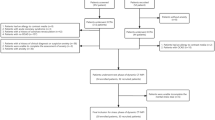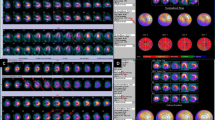Abstract
Objective
Mental stress can induce myocardial ischemia in patients with anxiety and other psychological disorders. Computed tomography myocardial perfusion imaging (CT-MPI) has the potential to quantitatively diagnose myocardial ischemia. The aim of this study was to measure changes in myocardial microcirculation perfusion (MMP) in patients with anxiety who have angina symptoms/ischemia but no obstructive coronary artery disease (INOCA) using dynamic CT-MPI in combination with a mental stress test.
Methods
Patients with INOCA were divided into five subgroups (none, minimal, mild, moderate, and severe) according to the generalized anxiety disorder scale. Patients underwent dynamic CT-MPI with mental stress testing using a series of the standardized color word/arithmetic stressors. Myocardial blood flow (MBF) during resting and stress phases of CT-MPI was recorded.
Results
Fifty-eight patients with 986 segments were included for final analysis. Compared to patients with none, minimal, mild, and moderate anxiety, those with severe anxiety had the largest rate of MBF decrease and the largest MBF decrease value. At the same time, those with no anxiety had the largest rate of MBF increase, the largest MBF increase value (all p < 0.05). As anxiety intensified, the rate of MBF increased and the MBF value increased (r = −0.24, r = −0.27, p < 0.05). Concomitantly, the rate of MBF decreased and the MBF value decreased (r = 0.63, r = 0.43, p < 0.05).
Conclusions
Dynamic CT-MPI with a mental stress test can be used to evaluate MMP in patients with anxiety and INOCA. Mental stress resulted in significant differences in changes in the rate and value of MBF among patients with different anxiety degrees.
Key Points
• Dynamic CT-MPI with mental stress test worked well to quantitatively evaluate myocardial microcirculation perfusion in patients with anxiety and INOCA.
• The rates of MBF decrease and MBF decrease value were positively correlated with anxiety degree of anxiety patients with INOCA.
• MBF change derived from CT-MPI with mental stress test had a good performance to predicting anxiety degree of patients with anxiety and INOCA.






Similar content being viewed by others
Abbreviations
- CAD:
-
Coronary artery disease
- CCTA:
-
Coronary CT angiography
- CMD:
-
Coronary microvascular dysfunction
- CT-MPI:
-
Computed tomography myocardial perfusion imaging
- INOCA:
-
No obstructive coronary artery disease
- MBF:
-
Myocardial blood flow
- MMP:
-
Myocardial microcirculation perfusion
- MMP:
-
Myocardial microvascular dysfunction
- MSIMI:
-
Mental stress-induced myocardial ischemia
References
Jiang W, Velazquez EJ, Kuchibhatla M et al (2013) Effect of escitalopram on mental stress–induced myocardial ischemia: results of the REMIT trial. JAMA 309(20):2139–2149
Bekendam MT, Vermeltfoort IAC, Kop WJ, Widdershoven JW, Mommersteeg PMC (2022) Psychological factors of suspect coronary microvascular dysfunction in patients undergoing SPECT imaging. J Nucl Cardiol 29(2):768–778
McKinnon I, Shah AJ, Lima B et al (2021) Everyday discrimination and mental stress-induced myocardial ischemia. Psychosom Med 83(5):432–439
Yu L, Tao X, Dai X, Liu T, Zhang J (2021) Dynamic CT myocardial perfusion imaging in patients without obstructive coronary artery disease: quantification of myocardial blood flow according to varied heart rate increments after stress. Korean J Radiol 22(1):97–105
Li Y, Yu M, Dai X et al (2019) Detection of hemodynamically significant coronary stenosis: CT myocardial perfusion versus machine learning CT fractional flow reserve. Radiology 293(2):305–314
Sørgaard MH, Linde JJ, Kühl JT et al (2018) Value of myocardial perfusion assessment with coronary computed tomography angiography in patients with recent acute-onset chest pain. JACC Cardiovascular Imaging 11(11):1611–1621
Yu M, Shen C, Dai X et al (2020) Clinical outcomes of dynamic computed tomography myocardial perfusion imaging combined with coronary computed tomography angiography versus coronary computed tomography angiography-guided strategy. Circ Cardiovasc Imaging 13(1):e009775
Kwon O, Hwang HJ, Koo HJ et al (2019) Ischemic burden assessment of myocardial perfusion CT, compared with SPECT using semi-quantitative and quantitative approaches. Int J Cardiol 278:287–294
Löwe B, Decker O, Müller S et al (2008) Validation and standardization of the Generalized Anxiety Disorder Screener (GAD-7) in the general population. Med Care 46(3):266–274
Spitzer RL, Kroenke K, Williams JB, Lowe B (2006) A brief measure for assessing generalized anxiety disorder: the GAD-7. Arch Intern Med 166(10):1092–1097
Stroop JR (1935) Studies of interference in serial verbal reactions. J Exp Psychol 18(6):643–662
Freund MC, Bugg JM, Braver TS (2021) A representational similarity analysis of cognitive control during color-word stroop. J Neurosci 41(35):7388–7402
Moazzami K, Sullivan S, Lima BB et al (2021) Mental stress-induced myocardial ischemia and cognitive impairment in coronary atherosclerosis. J Psychosom Res 141:110342
Moazzami K, Wittbrodt MT, Lima BB et al (2020) Higher activation of the rostromedial prefrontal cortex during mental stress predicts major cardiovascular disease events in individuals with coronary artery disease. Circulation 142(5):455–465
Rossi A, Merkus D, Klotz E, Mollet N, de Feyter PJ, Krestin GP (2014) Stress myocardial perfusion: imaging with multidetector CT. Radiology 270(1):25–46
Cerqueira MD, Weissman NJ, Dilsizian V et al (2002) Standardized myocardial segmentation and nomenclature for tomographic imaging of the heart. A statement for healthcare professionals from the Cardiac Imaging Committee of the Council on Clinical Cardiology of the American Heart Association. Circulation 105(4):539–542
Group DT, Maurovich-Horvat P, Bosserdt M et al (2022) CT or invasive coronary angiography in stable chest pain. N Engl J Med 386(17):1591–1602
Takx RAP, Celeng C, Schoepf UJ (2018) CT myocardial perfusion imaging: ready for prime time? Eur Radiol 28(3):1253–1256
Brindhaban A (2020) Effective dose to patients from SPECT and CT during myocardial perfusion imaging. J Nucl Med Technol 48(2):143–147
Borren NM, Gerritse TJ, Ottervanger JP et al (2021) Semi-quantitative assessment of ischemia with rubidium-82 PET myocardial perfusion imaging. J Nucl Cardiol. https://doi.org/10.1007/s12350-021-02884-4:1-8
Tonet E, Pompei G, Faragasso E et al (2021) Coronary microvascular dysfunction: PET, CMR and CT assessment. J Clin Med 10(9):1848
Meadows JL, Shah S, Burg MM, Pfau S, Soufer R (2020) The foundational role of cardiovascular imaging in the characterization of mental stress-induced myocardial ischemia in patients with coronary artery disease. Curr Cardiol Rep 22(12):162
Helmark C, Harrison A, Pedersen SS, Doherty P (2022) Systematic screening for anxiety and depression in cardiac rehabilitation - are we there yet? Int J Cardiol 352:65–71
Nieman K, Balla S (2020) Dynamic CT myocardial perfusion imaging. J Cardiovasc Comput Tomogr 14(4):303–306
Nous FMA, Geisler T, Kruk MBP et al (2022) Dynamic myocardial perfusion CT for the detection of hemodynamically significant coronary artery disease. JACC Cardiovasc Imaging 15(1):75–87
Yu L, Lu Z, Dai X, Shen C, Zhang L, Zhang J (2021) Prognostic value of CT-derived myocardial blood flow, CT fractional flow reserve and high-risk plaque features for predicting major adverse cardiac events. Cardiovasc Diagn Ther 11(4):956–966
Deanfield J, Kensett M, Wilson R et al (1984) Silent myocardial ischaemia due to mental stress. The Lancet 324(8410):1001–1005
Nan N, Dong W, Gao B et al (2022) Association between quality of life and mental stress-induced myocardial ischaemia in high-risk patients after coronary revascularization. Health Qual Life Outcomes 20(1):69
Catalan A, Salazar de Pablo G, Aymerich C et al (2021) Neurocognitive functioning in individuals at clinical high risk for psychosis: a systematic review and meta-analysis. JAMA Psychiatry 78(8):859–867
Boyle SH, Samad Z, Becker RC et al (2013) Depressive symptoms and mental stress-induced myocardial ischemia in patients with coronary heart disease. Psychosom Med 75(9):822–831
Godo S, Takahashi J, Yasuda S, Shimokawa H (2021) Role of inflammation in coronary epicardial and microvascular dysfunction. Eur Cardiol 16:e13
Wirtz PH, von Kanel R (2017) Psychological stress, inflammation, and coronary heart disease. Curr Cardiol Rep 19(11):111
Sara JDS, Ahmad A, Toya T, Suarez Pardo L, Lerman LO, Lerman A (2021) Anxiety disorders are associated with coronary endothelial dysfunction in women with chest pain and nonobstructive coronary artery disease. J Am Heart Assoc 10(17):e021722
Sreenivasan J, Kaul R, Khan MS, Malik A, Usman MS, Michos ED (2022) Mental health disorders and readmissions following acute myocardial infarction in the United States. Sci Rep 12(1):3327
Celano CM, Millstein RA, Bedoya CA, Healy BC, Roest AM, Huffman JC (2015) Association between anxiety and mortality in patients with coronary artery disease: a meta-analysis. Am Heart J 170(6):1105–1115
Fotopoulos A, Petrikis P, Iakovou I et al (2020) The impact of depression and anxiety in prognosis of patients undergoing myocardial perfusion imaging with 99mTc tetrofosmin SPECT for evaluation of possible myocardial ischemia. Nucl Med Rev Cent East Eur 23(2):58–62
Bekendam MT, Mommersteeg PMC, Vermeltfoort IAC, Widdershoven JW, Kop WJ (2022) Facial emotion expression and the inducibility of myocardial ischemia during cardiac stress testing: the role of psychological background factors. Psychosom Med 84(5):588–596
Liu M, Liu J, Zhang L et al (2020) An evidence of brain-heart disorder: mental stress-induced myocardial ischemia regulated by inflammatory cytokines. Neurol Res 42(8):670–675
Wang C, Wang XR, Song DD et al (2020) The establishment of rat model in myocardial ischemia with psychological stress. Ann Transl Med 8(6):322
Weber C, Fangauf SV, Michal M et al (2022) Cortisol awakening reaction and anxiety in depressed coronary artery disease patients. J Clin Med 11(2):374
Funding
The authors state that this work has not received any funding.
Author information
Authors and Affiliations
Corresponding authors
Ethics declarations
Guarantor
The scientific guarantor of this publication is Xiaofeng Qu.
Conflict of interest
The authors of this manuscript declare no relationships with any companies, whose products or services may be related to the subject matter of the article.
Statistics and biometry
No complex statistical methods were necessary for this paper.
Informed consent
Written informed consent was obtained from all subjects (patients) in this study.
Ethical approval
Institutional Review Board approval was obtained.
Methodology
-
prospective
-
cross-sectional study
-
performed at one institution
Additional information
Publisher's note
Springer Nature remains neutral with regard to jurisdictional claims in published maps and institutional affiliations.
Supplementary Information
Below is the link to the electronic supplementary material.
Rights and permissions
Springer Nature or its licensor (e.g. a society or other partner) holds exclusive rights to this article under a publishing agreement with the author(s) or other rightsholder(s); author self-archiving of the accepted manuscript version of this article is solely governed by the terms of such publishing agreement and applicable law.
About this article
Cite this article
Sun, W., Zhang, A., Mei, L. et al. Dynamic myocardial perfusion computed tomography with mental stress test to detect changes in myocardial microcirculation in patients with anxiety and no obstructive coronary artery disease. Eur Radiol 33, 6522–6533 (2023). https://doi.org/10.1007/s00330-023-09607-y
Received:
Revised:
Accepted:
Published:
Issue Date:
DOI: https://doi.org/10.1007/s00330-023-09607-y




